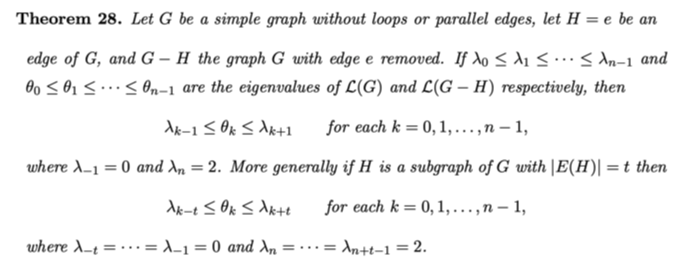I am stuck at the following :
Let $G$ be a graph and $A$ is its adjacency matrix. Let the eigenvalues of $A$ be $\lambda_1\le \lambda_2\leq \cdots \leq \lambda_n$.
If we remove some edges from the graph $G$ and form the graph $H$ keeping the number of vertices same, is there any result how the smallest eigenvalue of $H$ is related to the smallest eigenvalue of $G$?
I know Cauchy Interlacing Theorem which gives the relation between eigenvalues of a graph and its induced subgraph when some vertices are removed.
I want to know what happens when edges are removed keeping the number of vertices same. Can someone help please?
The question stands as:
Let $G$ be a graph and $A_G$ is its adjacency matrix. Let the eigenvalues of $A_G$ be $\lambda_1\le \lambda_2\leq \cdots \leq \lambda_n$.
Let $H$ be a subgraph of $G$ which has $n$ vertices as $G$ but some edges have been removed from $G$ to form $H$.$A_H$ is its adjacency matrix.
Let the eigenvalues of $A_H$ be $\mu_1\le \mu_2\leq \cdots \leq \mu_n$.
Is $\mu_1\ge \lambda_1$ or $\mu_1\le \lambda_1$?
If someone can give any reference like book or paper , I will be grateful.

